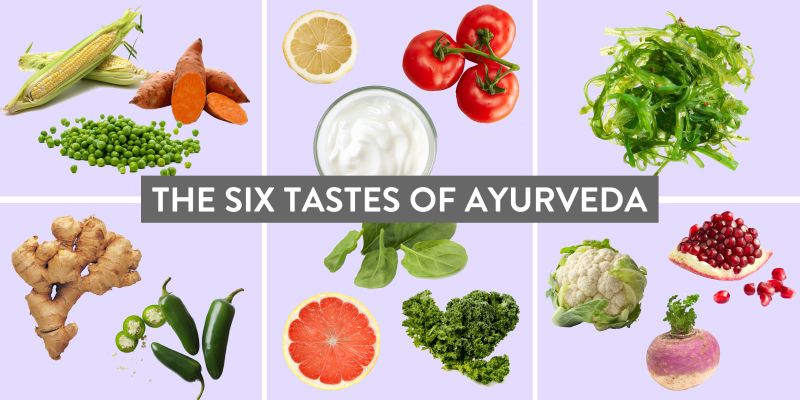
11 Dec 2021 HYN Himalayan Yoga Academy
Himalayan Yoga Academy presents an article on the Tastes and the Doshas. Our taste buds do much more than simply identify tastes. They also unlock the nutritional value of foods and kick-start the digestion process. Ayurveda generally identifies that all foods have all five natural elements, but usually only one or two are dominant: Space, Air, Fire, Water, Earth
Various Tastes and the Doshas
Sweet
Sweet taste is mildly cooling, strongly increases Kapha, mildly decreases Vata and Pitta. This taste is particularly good for children, seniors, and those who are recovering from injuries, as this form of increase to kapha will tend to nourish and strengthen body tissues. This promotes healing as it improves the immune system. It is the foundation for ojas, a subtle energy that promotes health in all three dimensions- physical, emotional, and spiritual.
Sweet taste can relieve thirst. We commonly see that as people age, the vitality of their senses diminishes. As a result, the sensation of thirst is often misperceived as a desire for something sweet to eat. Thus instead of promoting a balance in kapha, the body tissue increases and lethargy is promoted by a misconstrued desire for sweets.
Sweet taste is predominant in sugars like cane and maple syrup (which are cooling), beet sugar and honey (both are heating), rice, milk, dates, licorice and oils from seeds and nuts. It is most balanced in whole grain starches.
In excess, it can damage the spleen or pancreas and cause hypoglycemia or diabetes. It will contribute to excessive weight gain, lethargy, loss of appetite, cough, and insomnia. In general its over consumption promotes the ageing process.
Salty
This taste is mildly heating, mildly increases Kapha, increases Pitta, and strongly decreases vata. It stimulates salivation and digestion and works as a sedative and in larger quantities is a laxative. It can alleviate stiffness in small quantities. The naturally occurring in mineral salts and seafoods, shellfish and seaweeds.
When excessive, is can damage the kidneys and cause edema or hypertension. It can thus over stimulate Pitta causing weakness, wrinkles, hair loss, and inflammatory skin diseases. On the other side of the issue, cramping is a sign of a Vata imbalance often caused by a lack of sea salt or diminished mineral absorption.
Sour
This taste is moderately heating, strongly increases Pitta, mildly increases Kapha, and moderately decreases Vata. It increases appetite, digestion, thirst, and elimination and diminishes Vata to release gas. It is a beneficial taste for promoting sensory awareness and mental acuity. Available in citrus fruits, berries, sour fruits like pineapple, cheese, hibiscus, and rosehip tea, and fermented foods such as yogurt and kefir.
Too much sour taste causes acidity, burning sensation, and bleeding. In the long run it can cause gastritis or peptic ulcers. It also increases sensitivity in the teeth, edema, ulcers and heartburn.
Bitter
Bitter taste is strongly cooling, strongly increases Vata, decreases Pitta, and moderately decreases Kapha. It can be cleansing to the taste buds as it causes a withdrawal reaction making them discharge excessive tastes that were overstimulated. It is a remedy for fainting, itching, reducing fevers and burning sensations. The bitter taste is found in herbs such as gentian root, dandelion root, fenugreek, and goldenseal as well as rhubarb.
Bitter taste taken excessively causes coldness in hands and feet, vertigo, emaciation; continued excessive use may damage the heart to cause anemia, low blood pressure or insomnia.
Pungent
This taste is strongly heating, moderately increases Pitta, mildly increases Vata, and strongly decreases Kapha. Because it increases Pitta, it can improve mental activity, appetite, and digestion as well as improve the taste of food. It helps eliminate excessive Kapha and is helpful for poor circulation, lessening blood clots, and edema, thus promoting the elimination of ama. Pungent is a taste not detectable according to Western concepts of digestive physiology. A pungent taste is prevalent in aromatic spices like ginger, cayenne, cardamom, and mint. It is also in coffee and tea. Excessive use of these beverages may aggravate the conditions described below.
Pungent taste taken too excessively causes burning sensation, dryness, weakness, fainting, tissue depletion, and can adversely affects the lungs and digestive tract. In moderation, pungent promotes proper weight, but excessive use will lead to congestion and constipation.
Astringent
This taste has a sedative and moderately cooling effect, moderately increases Vata, decreases Pitta, and mildly decreases Kapha. It is anti-inflammatory and promotes vasoconstriction, stops diarrhea, reduces sweating, aids in healing, and promotes the clotting of blood. Astringent is another taste not recognized by Western concepts of physiology. It is experienced in tree bark and resin-like myrrh and frankincense. It is also present in pomegranate, unripe bananas, and herbs such as turmeric, alum, and goldenseal.
Astringent taste in excess causes contractions, muscle tension, constipation, obstructs speech by drying the mouth, and may increase Vata based nerve disorders such as numbness, spasms, and pain.
